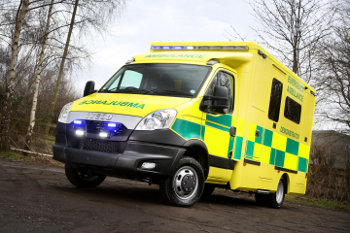
The new Iveco – Cartwright ambulance
No sooner do I write an article about German supremacy in the UK ambulance market, than a competing British firm announces that it has launched a new ambulance body that is designed to be mounted on an Italian van chassis!
Iveco and Cartwright have teamed up to launch a new accident & emergency (A&E) ambulance, which is being made available for trials with NHS Ambulance Trusts and private ambulance operators across the UK and Ireland.
The body has been designed and developed within Cartwright’s 38-acre manufacturing site in Altrincham, Cheshire, using materials proven in aerospace and motorsport environments, combined with cutting edge metallurgy and the company’s 62 years of experience in vehicle body design. Cartwright says the body is unique in the marketplace for being easily transferable onto a second chassis, of any make, during a projected 15 year minimum service life.
The launch vehicle is based on an Iveco Daily 50C17 chassis, which is popular with blue light operators throughout Europe. Key features include its truck-style chassis frame which guarantees structural rigidity, fatigue resistance and long-term durability, combined with an impressive turning circle and a chassis offering maximum bodybuilding flexibility.
The bodywork comprises a unique combination of high strength fibre-reinforced plastic (FRP) laminates, high density structural foam core, special plastics manufactured by VEKA and high strength aluminium extrusions. The FRP laminate offers 90 per cent of the tensile strength of carbon fibre but at a cost acceptable within price driven arenas. Body joints are fully bonded; avoiding the localised stress raisers of welded, bolted or rivet joints by spreading the joint surface over the full contact area.
Key to the body’s modular nature is Cartwright’s decision to mount the lightweight body structure onto a reinforced substructure to provide a strong, rigid mounting point for battery lockers, step wells, steps and tail-lift. Unlike existing ambulance bodies in the UK, this allows fleets the option to remount the body onto a different chassis and wheelbase in the future – ensuring the base vehicle can be replaced after approximately seven or eight years in service, in line with current industry standards.
Wes Linton, Blue Light Development Engineer at Cartwright Group, says:
“Ambulance electrical systems are worked extremely hard with constant parasitic communications loads combined with regular high current requirements for the tail-lift. For this new body, we have developed what we are confident is the most advanced electrical system of its type in the blue-light sector.”
This sees a DC-DC step-up charger providing 100A continuous charge current capacity to feed the split-charge system. The split-charge system is monitored and controlled using the actual battery bank state-of-charge, operating to charge the individual banks at predefined precedence and within adjustable thresholds to ensure the battery banks are kept at their maximum charge.
The electrical control system has been designed from the outset to utilise CAN signals where possible and integrate directly with telematics systems. Utilising twin CAN networks the Intellitec iPLC based control system has direct control over all aspects of base vehicle interfaces, battery management and charge control, systems control and event logging.
The demonstrator model is powered by a 3.0 litre FPT Industrial diesel engine which is capable of producing up to 170 hp between 3,000 and 3,500 rev/min, combined with a maximum output of 400 Nm of torque between 1,250 and 2,600 rev/min. This ensures sufficient power to meet the rapid response times demanded in the blue light sector.
